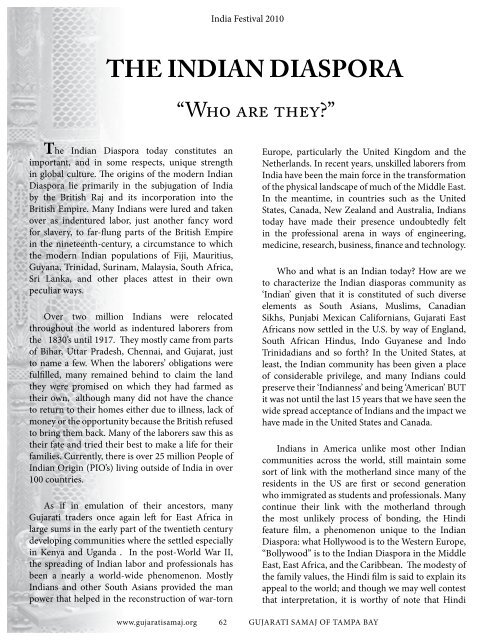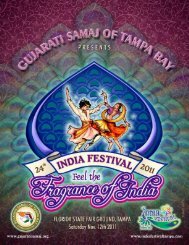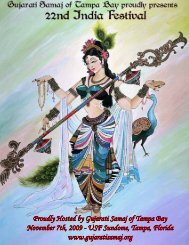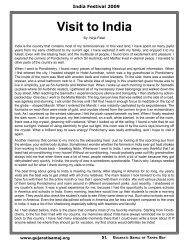You also want an ePaper? Increase the reach of your titles
YUMPU automatically turns print PDFs into web optimized ePapers that Google loves.
<strong>India</strong> <strong>Festival</strong> <strong>2010</strong><br />
THE INDIAN DIASPORA<br />
“Who are they?”<br />
The <strong>India</strong>n Diaspora today constitutes an<br />
important, and in some respects, unique strength<br />
in global culture. The origins of the modern <strong>India</strong>n<br />
Diaspora lie primarily in the subjugation of <strong>India</strong><br />
by the British Raj and its incorporation into the<br />
British Empire. Many <strong>India</strong>ns were lured and taken<br />
over as indentured labor, just another fancy word<br />
for slavery, to far-flung parts of the British Empire<br />
in the nineteenth-century, a circumstance to which<br />
the modern <strong>India</strong>n populations of Fiji, Mauritius,<br />
Guyana, Trinidad, Surinam, Malaysia, South Africa,<br />
Sri Lanka, and other places attest in their own<br />
peculiar ways.<br />
Over two million <strong>India</strong>ns were relocated<br />
throughout the world as indentured laborers from<br />
the 1830’s until 1917. They mostly came from parts<br />
of Bihar, Uttar Pradesh, Chennai, and Gujarat, just<br />
to name a few. When the laborers’ obligations were<br />
fulfilled, many remained behind to claim the land<br />
they were promised on which they had farmed as<br />
their own, although many did not have the chance<br />
to return to their homes either due to illness, lack of<br />
money or the opportunity because the British refused<br />
to bring them back. Many of the laborers saw this as<br />
their fate and tried their best to make a life for their<br />
families. Currently, there is over 25 million People of<br />
<strong>India</strong>n Origin (PIO’s) living outside of <strong>India</strong> in over<br />
100 countries.<br />
As if in emulation of their ancestors, many<br />
Gujarati traders once again left for East Africa in<br />
large sums in the early part of the twentieth century<br />
developing communities where the settled especially<br />
in Kenya and Uganda . In the post-World War II,<br />
the spreading of <strong>India</strong>n labor and professionals has<br />
been a nearly a world-wide phenomenon. Mostly<br />
<strong>India</strong>ns and other South Asians provided the man<br />
power that helped in the reconstruction of war-torn<br />
Europe, particularly the United Kingdom and the<br />
Netherlands. In recent years, unskilled laborers from<br />
<strong>India</strong> have been the main force in the transformation<br />
of the physical landscape of much of the Middle East.<br />
In the meantime, in countries such as the United<br />
States, Canada, New Zealand and Australia, <strong>India</strong>ns<br />
today have made their presence undoubtedly felt<br />
in the professional arena in ways of engineering,<br />
medicine, research, business, finance and technology.<br />
Who and what is an <strong>India</strong>n today? How are we<br />
to characterize the <strong>India</strong>n diasporas community as<br />
‘<strong>India</strong>n’ given that it is constituted of such diverse<br />
elements as South Asians, Muslims, Canadian<br />
Sikhs, Punjabi Mexican Californians, Gujarati East<br />
Africans now settled in the U.S. by way of England,<br />
South African Hindus, Indo Guyanese and Indo<br />
Trinidadians and so forth? In the United States, at<br />
least, the <strong>India</strong>n community has been given a place<br />
of considerable privilege, and many <strong>India</strong>ns could<br />
preserve their ‘<strong>India</strong>nness’ and being ‘American’ BUT<br />
it was not until the last 15 years that we have seen the<br />
wide spread acceptance of <strong>India</strong>ns and the impact we<br />
have made in the United States and Canada.<br />
<strong>India</strong>ns in America unlike most other <strong>India</strong>n<br />
communities across the world, still maintain some<br />
sort of link with the motherland since many of the<br />
residents in the US are first or second generation<br />
who immigrated as students and professionals. Many<br />
continue their link with the motherland through<br />
the most unlikely process of bonding, the Hindi<br />
feature film, a phenomenon unique to the <strong>India</strong>n<br />
Diaspora: what Hollywood is to the Western Europe,<br />
“Bollywood” is to the <strong>India</strong>n Diaspora in the Middle<br />
East, East Africa, and the Caribbean. The modesty of<br />
the family values, the Hindi film is said to explain its<br />
appeal to the world; and though we may well contest<br />
that interpretation, it is worthy of note that Hindi<br />
www.gujaratisamaj.org 62 GUJARATI SAMAJ OF TAMPA BAY










